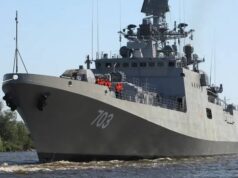Chinese J10 Fighter A Big Flop
 China is again making a major effort to sell its J-10 jet fighter to export customers but has not been able to fool any other country not even it’s economic slave Pakistan which has bought JF17s after much prodding and pushing.
China is again making a major effort to sell its J-10 jet fighter to export customers but has not been able to fool any other country not even it’s economic slave Pakistan which has bought JF17s after much prodding and pushing.
The J-10CE, the new avatar of the Chinese Air Force J-10C was on display at a November 2019 air show, is meant for export. However in spite of the eager sales reps at the show till date no new customer has been snared yet. There were only some enquiries from here and there.
The J-10CE appearance wise resembled the J10C but are minus the Chines IFF (Identify Friend or Foe) transponders and similar China-specific features of the communications and defensive systems.
Chinese have been trying to fool the customers by touting the J-10CE as having the same capabilities as the latest version F-16V or (as offered to India the F-21…..an USA attempt to fool India ).
The J-10CE is supposed to have all the advanced electronics as in the F-16V as well as some stealth features like radar absorbing surfaces and stealthy air intakes. The Chinese emphasis is also on the fact that the J-10CE costs only $40 million, half of what the F-16V was selling for. That was also a lot less than modern European jets like Eurofighter or Rafale as well as the latest Russian offerings like the MiG-35 or the latest Sukhoi models.
The F-16 was indeed an exceptional fighter with good service and combat record and was the most widely exported post-Cold War fighter. Indeed when USA sold these to Pakistan suddenly the PAF achieved combat superiority over the IAF. Then India had to hurriedly go in for Mirage 2000 and Mig 29 s to retain the edge. Worry got over only with induction of SU 30 MKIs.
The J-10 first flew in 1998 and entered service six years later. Less than 500 J-10s have been produced so far and none have been bought by export customers. The F-16 had entered service in 1978, four years after the first flight and nearly 5,000 have been produced so far. Over a third of F-16s were purchased by export customers and sales are still brisk.
The J-10 is considered very unsafe to operate with at least eight of them crashing since 2014. The F-16 has a much better safety record. The Middle East is full of satisfied F-16 customers, including Turkey, Israel, Egypt, Iraq and several Persian Gulf states. This satisfaction has been expressed by repeat orders for F-16s.
In 2017 Bahrain ordered another 22 F-16V jet fighters along with upgrades of their existing F-16s to the F-16V standard. This deal involved a lot of additional equipment, training and tech support for all the Bahrani F-16s and cost a total of $3.86 billion. The F-16V Block 70 is similar to the F-16E Block 60 “Desert Eagle” the UAE (United Arab Emirates) next door has been using since 2005.
Bahrain has been using F-16s since 1990 and has already upgraded them with items like targeting pods and the ability to deliver smart bombs like JDAM (GPS). Originally their F-16s were mainly used for air defence but ones like the F-16E and the Israeli F-16I were obviously more effective.
The Chinese are undeterred and keep pestering countries for export of their J-10 claiming improvement on it all the time. The latest version of the J-10 fighter, the J-10C, entered service in mid-2017, 13 years after the first J-10s entered service in 2004. This in itself was after a long (since 1988) effort to get an original modern Chinese fighter design operational.
This latest J-10 version uses more composites in the airframe and has improved electronics. This includes a new AESA radar. The J-10 is the most widely used modern Chinese jet fighter, with over 400 in service. It can best be compared with the Mig21 Bisons of the Indian Air Force. The same which downed a F16 in a one to one dog fight
In mid-2019 China finally formed its first fighter squadron equipped with J-10C. There were about 40 J-10Cs in service then and a full-strength fighter squadron has 24 aircraft. It is unclear if the first J-10C squadron was at full strength, many squadrons are not. The J-10C began arriving at the new squadron in May 2019 and many were still being used for training and testing.
Until 2019 the J-10 still depended on the more reliable Russian made AL-31 engines. That has now changed with the WS10 standard on all newly built J-10s and for those in need of an engine replacement
Before the J-10 entered service China began buying the most modern Russian fighters (Su-27/30) in the 1990s and were able to buy and steal a lot of Russian aircraft tech during the 1990s because Russia was broke and the only thing keeping the Russian military aviation producers in business was export sales. Before the 1990s ended China had created an illegal copy of the Su-27, calling it the “Chinese developed” J11.
Only two jet fighters designed in China were offered for export; the J-10 and the JF-17. The JF-17 was designed as a joint effort with Pakistan. Until 1989, when the U.S. imposed sanctions,American aircraft firm Grumman was also involved. China and Pakistan continued alone.
While prototypes and most of the components for the JF-17 were Chinese built, the main export customer was Pakistan and China never bought any, mainly because by the time the JF-17 was in service (2007) the J-10 was already in production and was considered a superior aircraft.
Technically the JF-17 is a Pakistani aircraft because most are assembled there. Pakistan has exported some to Burma and Nigeria because Russia agreed to supply and support the RD-93 engines required. Pakistan was not interested in the J-10 because it also had F-16s, and also had the locally assembled JF-17.
The J-10 looks something like the American F-16 and weighs about the same (19 tons). Like the F-16 the J-10 has only one engine and the aircraft is longer than the F-16 to accommodate the larger Russian/Chinese engines. It’s no accident that the J-10 resembles the F-16 because Israel sold China the technology for their Lavi jet fighter, a “super-F-16” design that Israel abandoned in 1987 because it was too expensive.
China always insisted the J-10 was an original Chinese design but after the Soviet Union collapsed in 1991 a lot of Russian engineers and scientists who assisted China in developing the J-10 revealed details about how the Chinese had access to the Lavi design data and used it extensively. Israel won’t comment because the U.S. cracked down on Israeli sales of military technology to China during the 1990s.
China has gone on to develop several stealth fighter designs that are sufficiently “Chinese” (and not stolen foreign tech) to be offered for export. Not many takers, not yet anyway. China appears to feel their new stealth designs are not ready for active service or export customers.
Getting all the new tech working together, as well as developing a powerful enough engine, are major obstacles. A less powerful Chinese engine is being used temporarily. While China declared its J-20 stealth fighter ready for service in 2019, the reality was it was still in development. China fears the J-20 will have some of the same problems that still plague the J-10
The J-10 turned out to perform poorly in air-to-air combat. In response, the Chinese concentrated on re-configuring the design to operate as fighter-bombers (the J-10B). This version carries over five tons of bombs and missiles and has been equipped with a fire control system for delivering missiles and smart bombs.
The J-10B didn’t enter service until 2014 and did not get its solid-state AESA radar until the J-10C, basically, an upgraded J-10B, appeared and was declared as capable as late-model F-16s. That was not true and potential export customers told the Chinese. China never find export customers for its jet fighters as it has no takers anywhere not even in Africa.
Though China already has few satisfied export customers for its large armed UAVs. These as Usual claim similar performance as the American Predator and Reaper but a lot cheaper.




